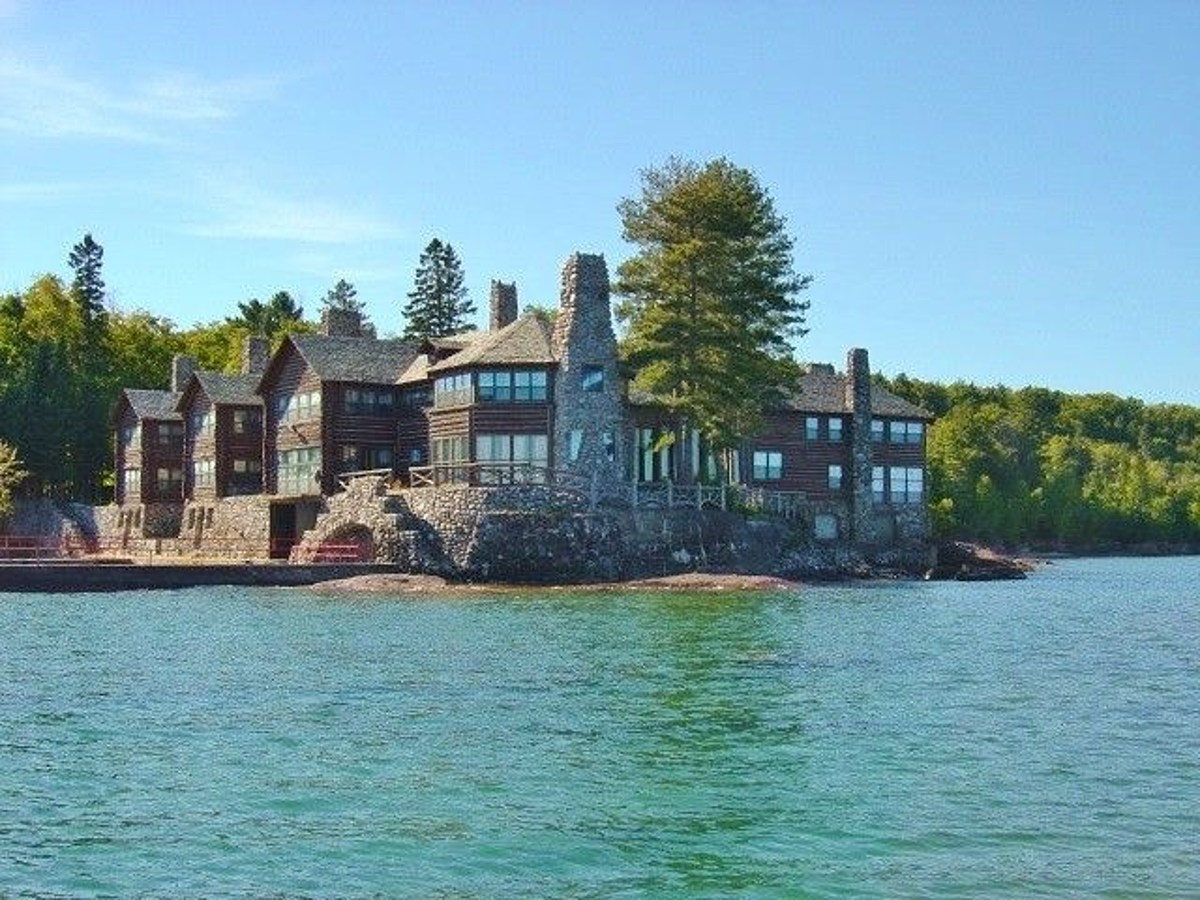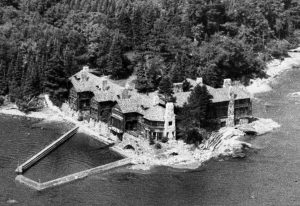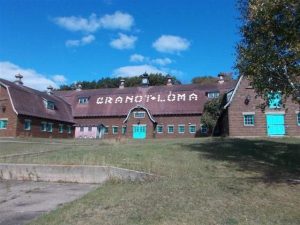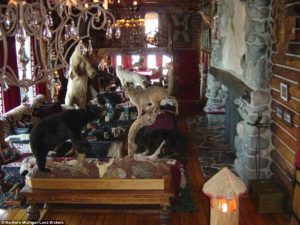
For Sale: Granot Loma – The Worlds Largest Log Cabin
Now here’s one that has real potential – it’s a log cabin, but nothing like the one you associate with Daniel Boone or the one where Abe Lincoln is reputed to have been born, nor the one where the Clampetts began their epic journey to Beverly Hills – Seriously – this one looks like a cabin on Crack. The Architects (Benjamin Henry Marshall and Charles Eli Fox of Marshall and Fox) certainly had very few limitations when designing it, but oh what a structure they created! It was listed as a National Historic site in 1991 and is noted as being the largest log cabin in the world. That accreditation I do have to question as there is an even larger (albeit commercial) log cabin – the Fairmont Le Château Montebello on The Ottawa River in Quebec (but what do I know?).
 Known as Granot Loma, the main building rests on the northern most tip of a 5,180 acre property dominating a small peninsula on the shores of Lake Superior just north of the city of Marquette, Michigan. Its odd name was apparently derived from the letters of Kaufman’s first three children, Louis, Graveraet and Otto along with Kaufman and his wife’s first names: Louis and Marie. Building remote and extensive complexes such as this was not an unusual pastime for the late nineteenth century elite, as similar camps were built by the Vanderbilts, the Astors, Rockefellers, even Marjorie Merriweather Post had camps, albeit these were mainly contained to the New York Adirondack Mountain area, within commuting distance of the owners Manhattan residences and businesses. Although Camps were never intended to be permanent homes, they were constructed as escapes from urban stresses and the highly structured living requirements of Gilded Age rules and opulence. Being rustic, rural escapes, however, did not mean these properties lacked the necessary luxuries their owners required – many mimicked or surpassed the attributes of their other more urban properties. These complexes not only featured electricity, hot and cold running water and indoor facilities (which was not yet the norm for many urban dwellers), but also contained staffing accommodations and facilities to support the elegant dining and extensive activities to which the leisure class had become accustomed.
Known as Granot Loma, the main building rests on the northern most tip of a 5,180 acre property dominating a small peninsula on the shores of Lake Superior just north of the city of Marquette, Michigan. Its odd name was apparently derived from the letters of Kaufman’s first three children, Louis, Graveraet and Otto along with Kaufman and his wife’s first names: Louis and Marie. Building remote and extensive complexes such as this was not an unusual pastime for the late nineteenth century elite, as similar camps were built by the Vanderbilts, the Astors, Rockefellers, even Marjorie Merriweather Post had camps, albeit these were mainly contained to the New York Adirondack Mountain area, within commuting distance of the owners Manhattan residences and businesses. Although Camps were never intended to be permanent homes, they were constructed as escapes from urban stresses and the highly structured living requirements of Gilded Age rules and opulence. Being rustic, rural escapes, however, did not mean these properties lacked the necessary luxuries their owners required – many mimicked or surpassed the attributes of their other more urban properties. These complexes not only featured electricity, hot and cold running water and indoor facilities (which was not yet the norm for many urban dwellers), but also contained staffing accommodations and facilities to support the elegant dining and extensive activities to which the leisure class had become accustomed.
 The complex was constructed between 1919 and 1923 by financier Louis G. Kaufman (November 13, 1870 – March 19, 1942) who built his fortune holding presidential roles in numerous US banking houses as well as along time seat on the General Motors Board of Directors. The 26,000 square foot Granot Loma main lodge was constructed at a then astronomical cost of over $5 million dollars by 400 Scandinavian craftsman imported specifically for the project. This main building contains over 50 rooms including: 23 bedrooms, 13 bathrooms, numerous sitting rooms, a kitchen modeled after the one in the White House, games room and a 60-foot-long assembly room anchored by a 30-foot-tall stone fireplace supporting a mantle crafted from the beam of a sunken ship salvaged from the depths of Lake Superior. 25 additional fireplaces are spread throughout the building. Additional supporting structures include a large boathouse, playhouse, four garages, tennis courts, an extensive 13 building farm complex (including a massive dairy barn crowned by an original Tiffany Clock) and several staff and guest buildings, you know, for overflow.
The complex was constructed between 1919 and 1923 by financier Louis G. Kaufman (November 13, 1870 – March 19, 1942) who built his fortune holding presidential roles in numerous US banking houses as well as along time seat on the General Motors Board of Directors. The 26,000 square foot Granot Loma main lodge was constructed at a then astronomical cost of over $5 million dollars by 400 Scandinavian craftsman imported specifically for the project. This main building contains over 50 rooms including: 23 bedrooms, 13 bathrooms, numerous sitting rooms, a kitchen modeled after the one in the White House, games room and a 60-foot-long assembly room anchored by a 30-foot-tall stone fireplace supporting a mantle crafted from the beam of a sunken ship salvaged from the depths of Lake Superior. 25 additional fireplaces are spread throughout the building. Additional supporting structures include a large boathouse, playhouse, four garages, tennis courts, an extensive 13 building farm complex (including a massive dairy barn crowned by an original Tiffany Clock) and several staff and guest buildings, you know, for overflow.
The interiors throughout the main building have been enhanced with custom murals painted by Orry Kelly, an Oscar winning costume designer who worked in the Hollywood studio system between 1932 and 1944 on many films including: 42nd Street, The Maltese Falcon, & Casablanca. In Kelly’s career his talents were acknowledged with 3 Academy Awards for Best Costume Design (An American in Paris, Les Girls, and Some Like It Hot) and a fourth nomination for Gypsy. The balance of the home’s decorating style includes a virtual zoo full of taxidermy animal parts which I find a little disconcerting, and numerous nods to Indigenous arts through murals, textiles and more than one teepee – one in an entertainment room and a teepee styled fireplace in a small sitting room.
 In 1987, Granot Loma’s current owner, a Chicago financier by the name of Tom Baldwin purchased the then 93-year-old lodge for $4.2 million, immediately investing 18 months and an additional $4 million to restore the main structures, and an additional two years to complete interior finishes and décor. I’m thinking he may be the one responsible for the taxidermy zoo in the living room.
In 1987, Granot Loma’s current owner, a Chicago financier by the name of Tom Baldwin purchased the then 93-year-old lodge for $4.2 million, immediately investing 18 months and an additional $4 million to restore the main structures, and an additional two years to complete interior finishes and décor. I’m thinking he may be the one responsible for the taxidermy zoo in the living room.
With no takers at the originally offered price, Granot Loma recently had a price reduction from the initial $40 million to $19.5 million while having the included acres reduced from 5,100 acres to 415 acres and one mile of Lake Superior shoreline. Probably a bargain when you think of the potential of the property, but the lodge will still need to find that unique purchaser. Someone properly financed (that goes without saying) but also an individual who desires a property of this size, style and instilled reclusiveness (and wants a place in the wilds of northern Michigan).
Of course, I’d be very interested in being the next owner of a prize like this one but have some serious concerns about reliable internet coverage of such a remote location – I mean I need to maintain my ability to stream Netflix and maintain my Amazon shopping cart!